
Volubilis
The Far Corner of the Roman Empire
Volubilis is a Berber-Roman city
a short distance north of Meknès.
It may have been the capital of the Kingdom of Mauretania
under Juba II,
who ruled from 25 BCE
to his death in 23 CE.
Juba's first wife was the daughter
of Cleopatra and Marc Antony.
Rome had installed Juba as their client-king.
In 44 CE, Mauretania became two Roman provinces:
Mauretania Caesariensis, in today's northern Algeria,
and Mauretania Tingitana, in today's northern Morocco,
named for its capital Tingis, now Tangier.
The coast had commercial ports that had been
trading with Carthage since before the 4th century BCE.
Berber tribes had controlled the interior
since the time of the Late Bronze Age Collapse around
1200–1150 BCE.
This was the extreme southwestern fringe of the Roman Empire.
After the Imperial Crisis of the Third Century,
much of Mauretania was reconquered by Berber tribes.
Christianity spread to parts of Mauretania in the third
century CE, but it was mostly confined to the port cities
in the east.
The interior kept the Romano-Berber religion,
which had been influenced by ancient Egyptian,
Punic, and Phoenician beliefs.
I would get to Volubilis by first riding a shared
grand taxi to
Moulay Idris,
and then walking about four kilometers to the ancient site.
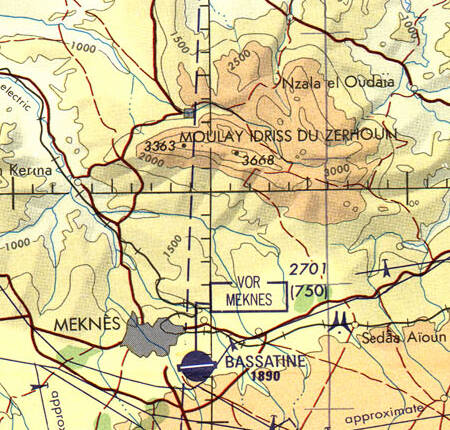
Portion of Tactical Pilotage Chart G-1D from the Perry-Castañeda Library Map Collection at the University of Texas at Austin.
My host at my guesthouse in a riad or traditional fortified building in the medina, explained the trip to me:
- Walk out through the medina to Place el-Hedim.
- Cross Place el-Hedim and the large street, and flag down a petit taxi going east, toward the train station.
- Ask to be taken to where the grands taxis gather to go to Moulay Idris.
- Once at the grand taxi station, stress that I don't want a private car, I want a seat in a shared taxi collectif.
It worked out exactly like that! Just 7 Dirham for the petit taxi to the grand taxi station. As expected, I was asked in French and English if I wanted to hire my own car and driver. No, just a taxi collectif to Moulay Idris. OK, 11 Dirham, get in that one. In just a few minutes it was full and we were on our way.

Idris I, known as Moulay Idris, had backed the losing side — the pro-Shi'a rebels — in the Battle of Fakh near Mecca in 786 CE. He fled west from the territory controlled by the Abbasid Caliphate, crossing North Africa and eventually arriving at the site of Volubilis. It was inhabited then by Berbers with a few Judeo-Christian inhabitants.
Idris was a sharīf, a descendant of the Prophet Muhammad. He used that connection to make an alliance with the local Berber tribe in 789, quickly becoming the most important religious and political leader in the region. He was Morocco's first major Muslim ruler.
Volubilis was on an open plain with very limited defensive structures. Idris led the people to abandon Volubilis and build a new settlement in the nearby mountains, probably roughly where today's town of Moulay Idris Zerhoun stands. (Or just Moulay Idris, or just Zerhoun)
Idris had fled civil war in Arabia. Five years later, having rapidly established himself in the Volubilis area, that past caught up. He died in 791, very likely poisoned by an assassin sent by Harun al-Rashid, the Abbasid Caliph in Baghdad.
Almost all Moroccans are Muslim, and almost all are Sunni. The Maliki branch of Sunni Islam is the dominant one in Morocco, and across all of North and West Africa. Compared to other Sunni branches, it is much more open to the veneration of saints and making pilgrimages to sites associated with them.
Idris quickly came to be considered a holy man. His mausoleum here became a major site of pilgrimage and remains so today. It and the associated mosque have gone through multiple renovations and complete reconstructions. Non-Muslims weren't allowed into the town until the start of the French Protectorate in 1912, and non-Muslims couldn't stay overnight until 2005.
Most of the people coming here either live here, have business here, or are Moroccans visiting the mausoleum of Moulay Idris I. As for me, I needed to start walking to Volubilis.
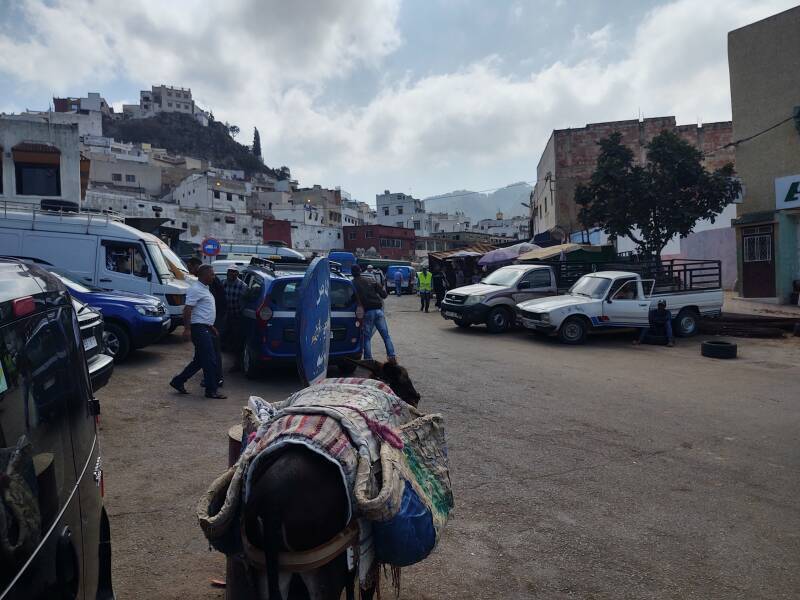
It's about four kilometers from the grand taxi gathering point in Moulay Idris to the site.
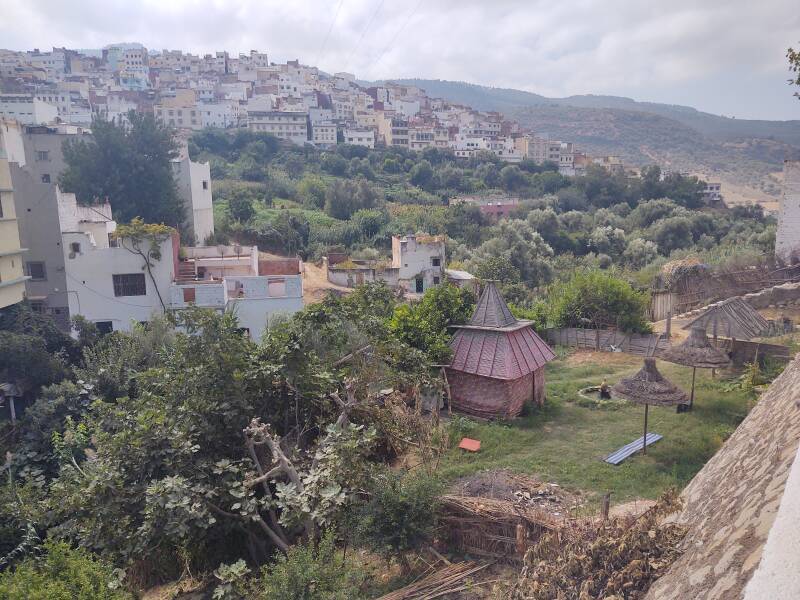
A man had pulled his van off the road and had an entire tea and coffee shop set up. I saw similar systems several times later during the trip. A full set of equipment built into the back of a van or car.
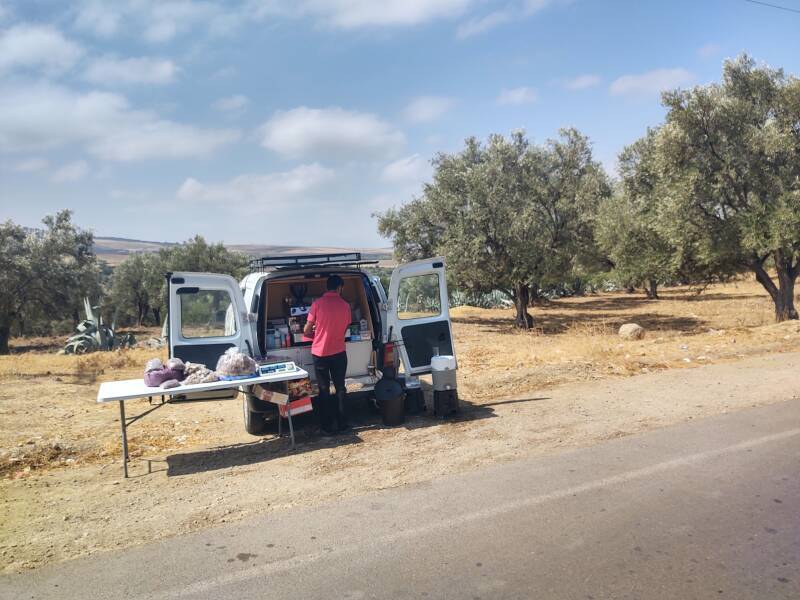
Before long I passed one of the outlying structures. These are olive trees. Olives have been a major cash crop here since the founding of Volubilis.
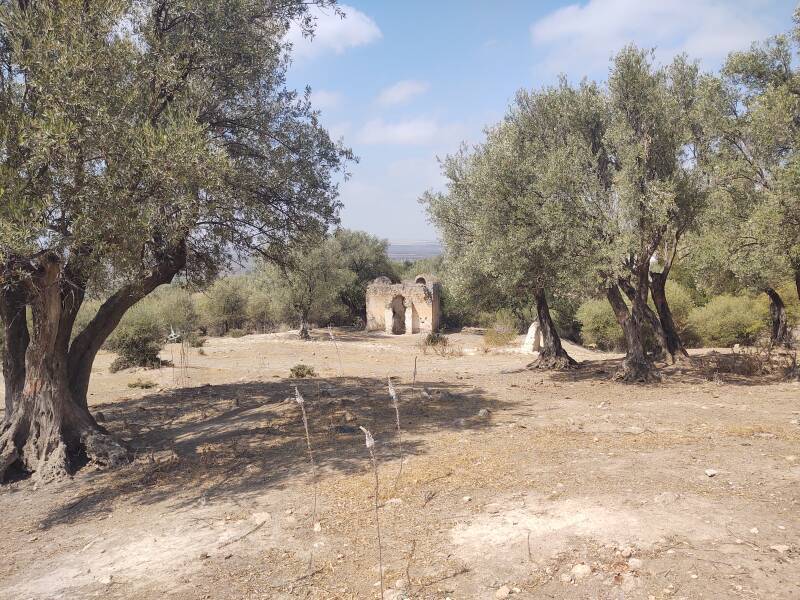
Volubilis grew under Roman rule to cover an area of about 40 hectares1 overlooking an agricultural plain.
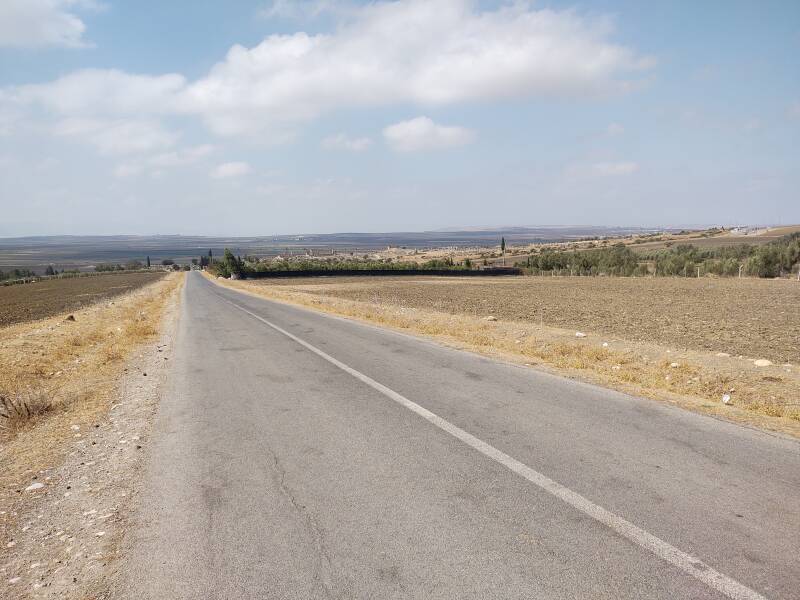
Olives
Entering the site and looking back to the town of Moulay Idris in the distance, I was looking over a facility used to process olives for their oil.
There's the round base of an olive mill lying in front of a structure with channels in its floor to gather oil.
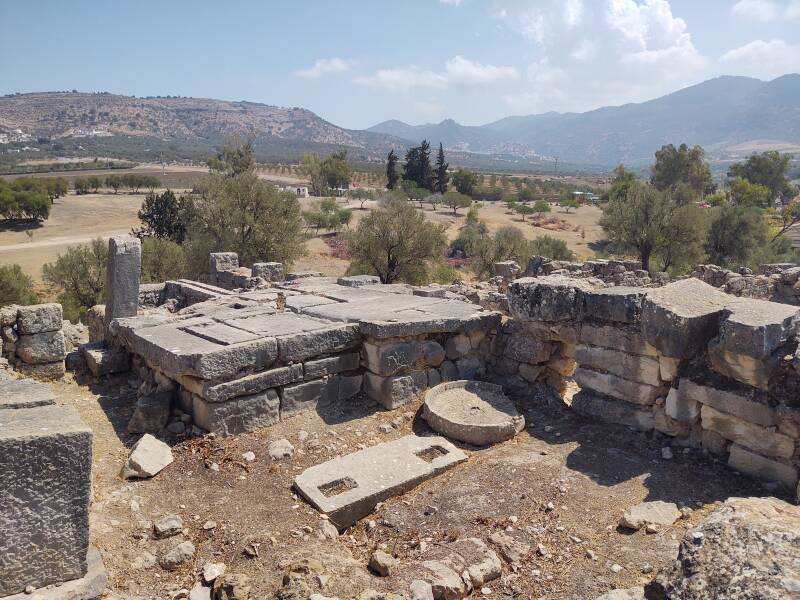
A building housing an olive press has been reconstructed.
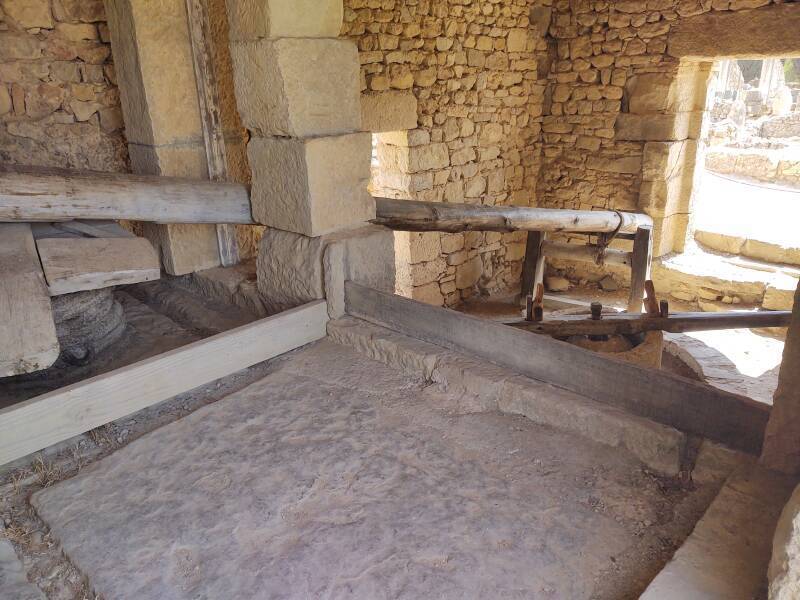
The olives were used primarily for their oil, which was used both in food and as lamp fuel.
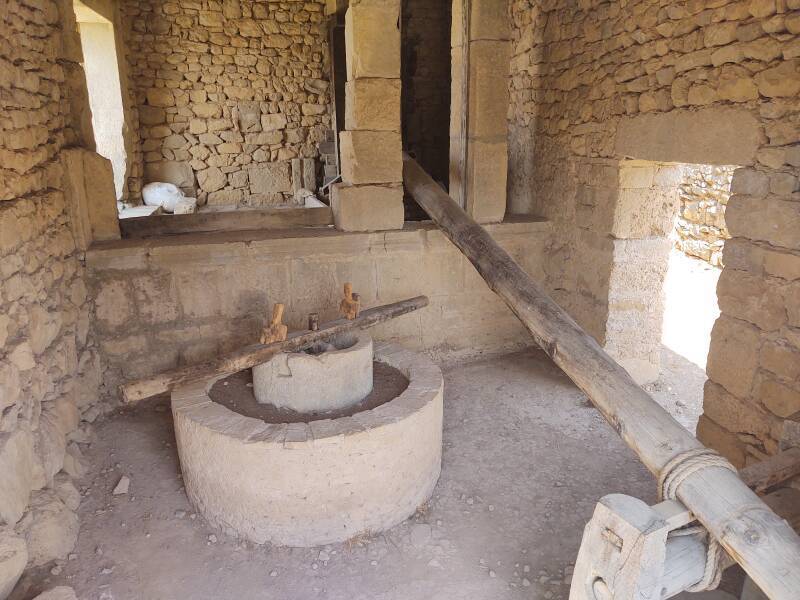
Baths of Gallienus
These baths dedicated to the Emperor Gallienus cover an area of 1,330 square meters. One end of the bath complex is next to yet another olive-processing facility.
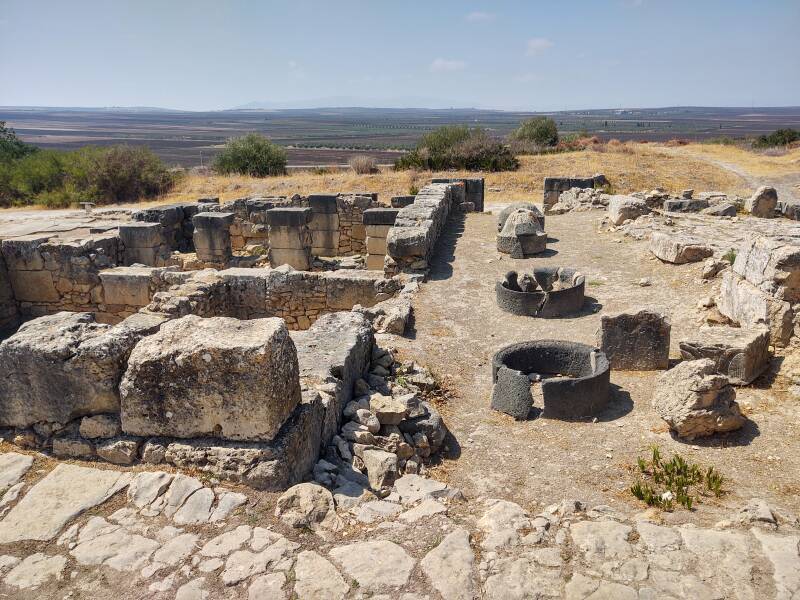
Gallienus ruled as Roman Emperor with his father Valerian from 253 to 260, and alone from 260 until his assassination in 268. This was during the Crisis of the Third Century, in which the Roman Empire nearly collapsed due to civil wars and political instability within the Empire, invasions and migrations by barbarians, and peasant rebellions.
VisitingGaul Visiting
Cappadocia Visiting
Palmyra
During Gallienus' reign the Franks were invading Gaul, Scythians had raided northern Asia Minor by sea and marched into Cappadocia, and Palmyra had become effectively independent of Rome.
The ancient historians writing soon after his reign blamed Gallienus for the empire's difficulties. The Historia Augusta describes him as a lover of luxury who always dressed in purple and sprinkled gold dust in his hair. The Emperor Julian (reigned 361–363) commissioned the history The Caesars, which described Gallienus as having "the dress and languishing gait of a woman".
After a long series of revolts and attempted usurpers, a conspiracy was finally successful and the officer Cecropius stabbed Gallienus to death.
Gallienus was succeeded by Claudius "Gothicus", also called Claudius II. He held power for two years before dying from a "pestilence", maybe the tail end of the roughly 249–262 Plague of Cyprian.

Within twenty years of Gallienus' assassination, Volubilis fell to the local Berber tribes around 285. Rome never tried to retake it.
Here is a swimming pool within the bath complex.
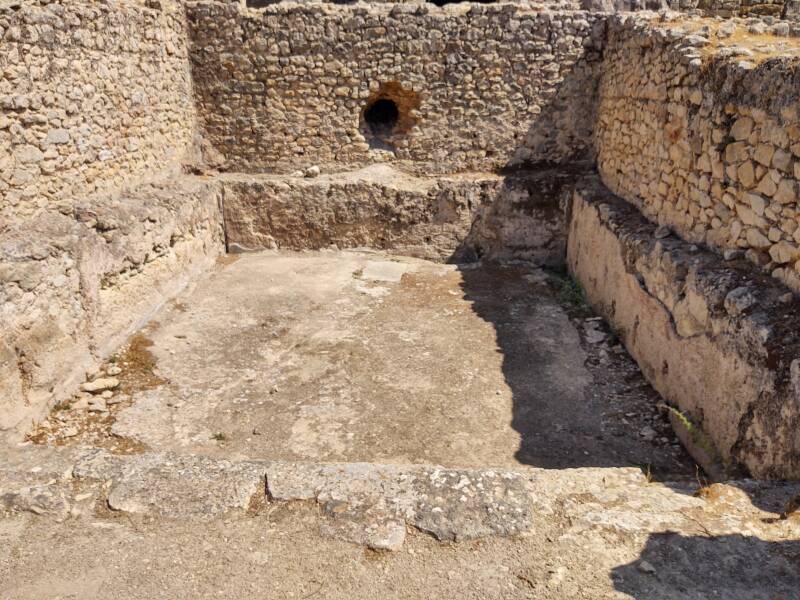
House of Orpheus
Prominent houses had their own baths. This is part of what is known as the House of Orpheus, due to a scene depicted in one of its mosaic floors. It's just across the street from the large public baths. Here you can see how the mosaic floors were above chambers in which water circulated at various temperatures.
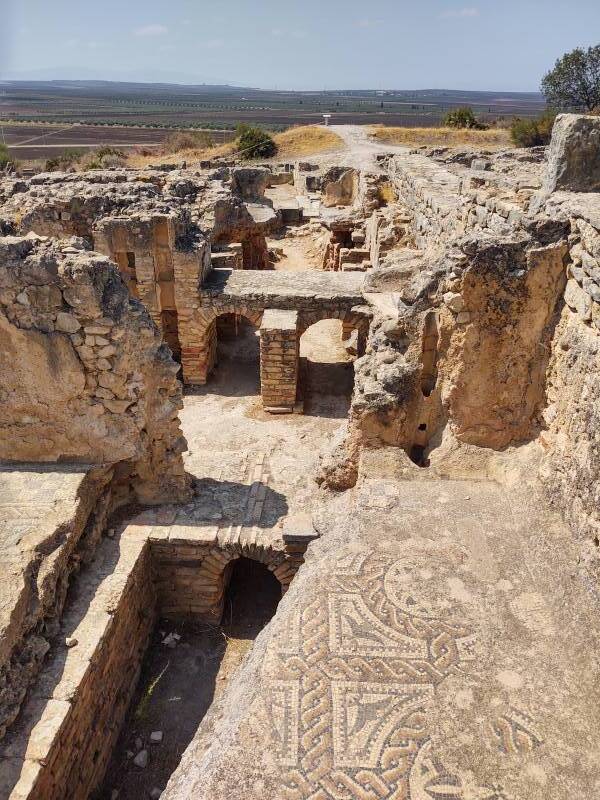
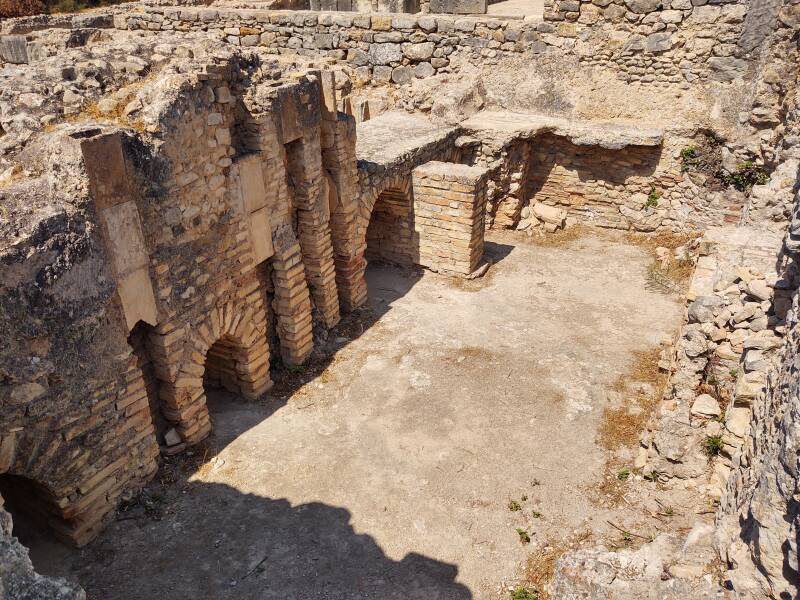
The House of Orpheus has several large mosaic floors. So many archaeological sites have had their mosaics removed, Volubilis is known for having many still in place.
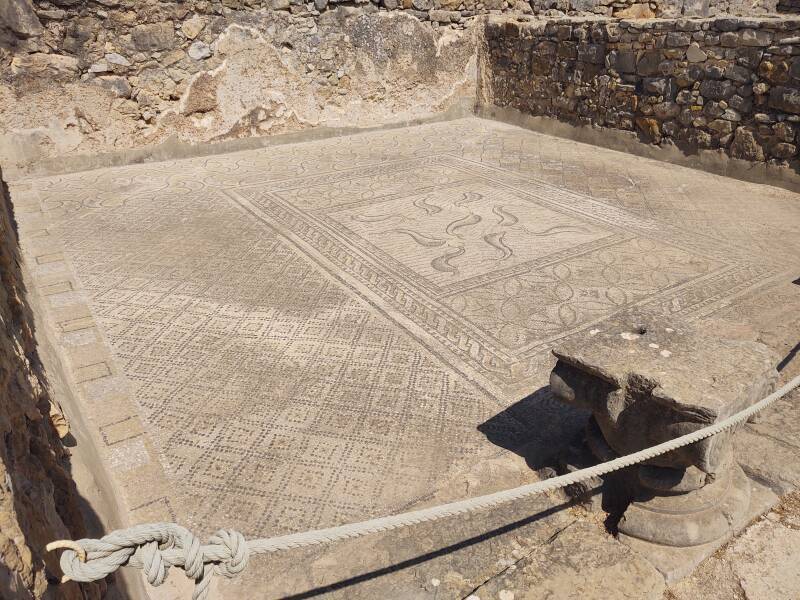
The House of Orpheus included a triclinum or τρικλίνιον, an area where guests could recline around three sides of a pool.
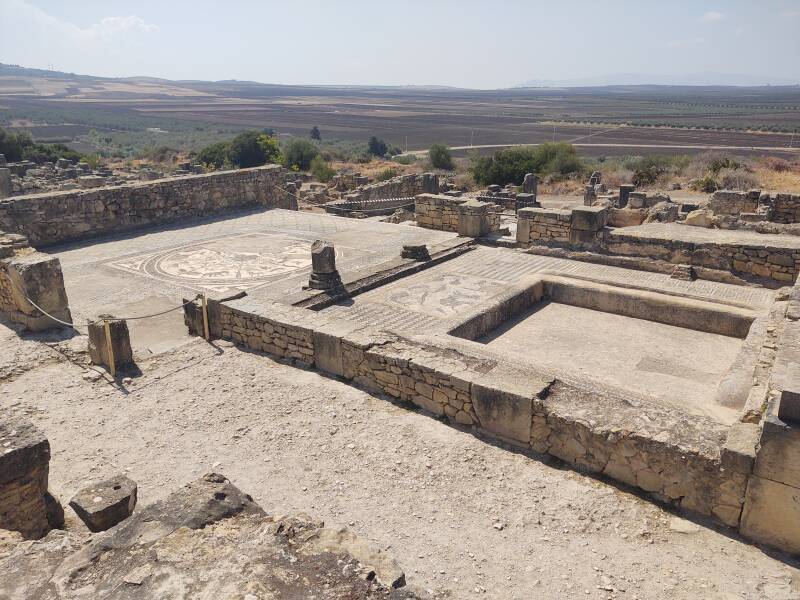

The adjacent space has a large mosaic depicting a variety of animals.

Volubilis
The house's large latrine had benches along two sides of a room with water flowing underneath.
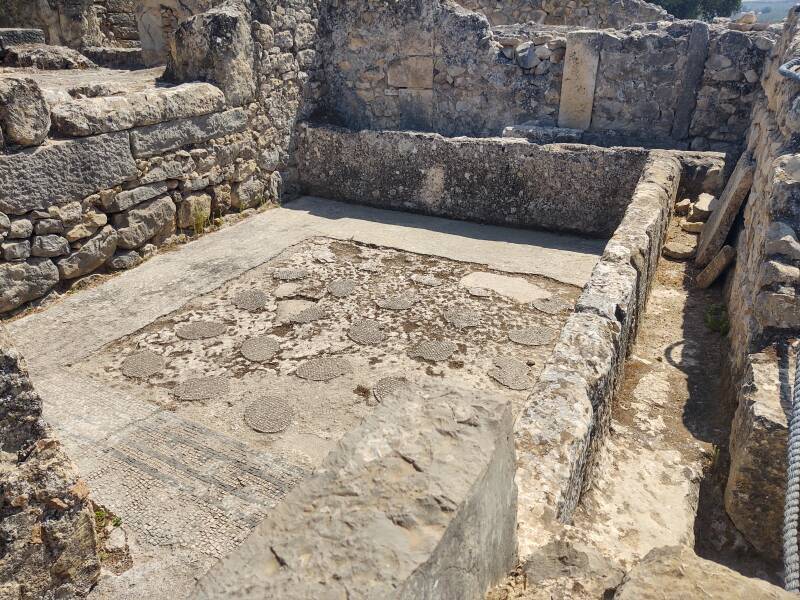
A large stone washbasin remains next to the entrance. There surely would have been a channel in the floor running past everyone's feet, used to wash yourself.
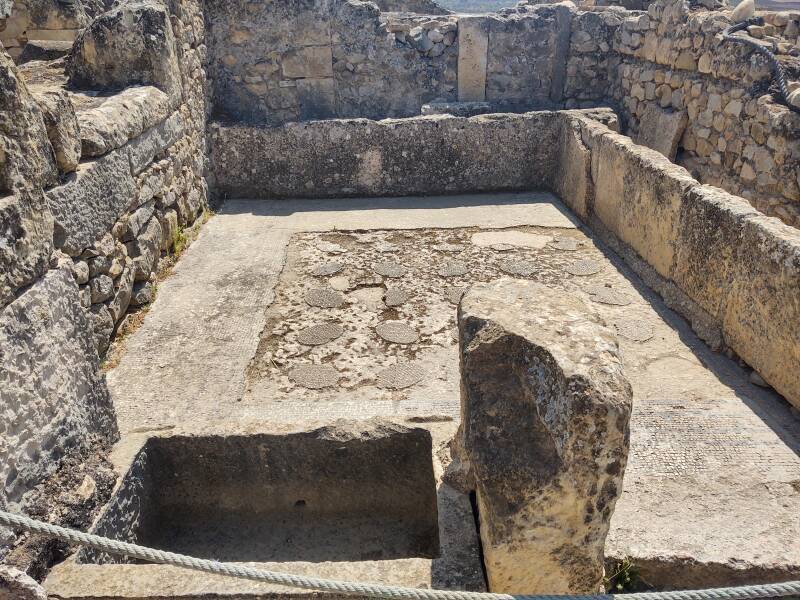
The Romans cleaned themselves with a tersorium, also called a xylospongium, a sponge mounted on a stick. The sponge could be dipped into a water channel running in front of the row of communal seats, and rinsed off in that channel after use. If there was no channel of running water, you could use a bucket of salt water or vinegar water, as Seneca described in his Letters of Lucillus [70,20].

Basilica and Temple
The Basilica and the Capitoline Temple stand near the center of Volubilis. They are beside the forum, which would have been filled with markets, small temples, and small government offices.
A basilica is a large public building of ancient Rome with a name from Ancient Greek, βασιλική στοά or a "royal stoa."
A typical Roman basilica was rectangular with a central nave flanked by two or more aisles. The aisles usually had lower roofs than the central nave, providing a clerestory of windows above the side aisles. An apse at the end held a raised platform where the government officials carried out their tasks.
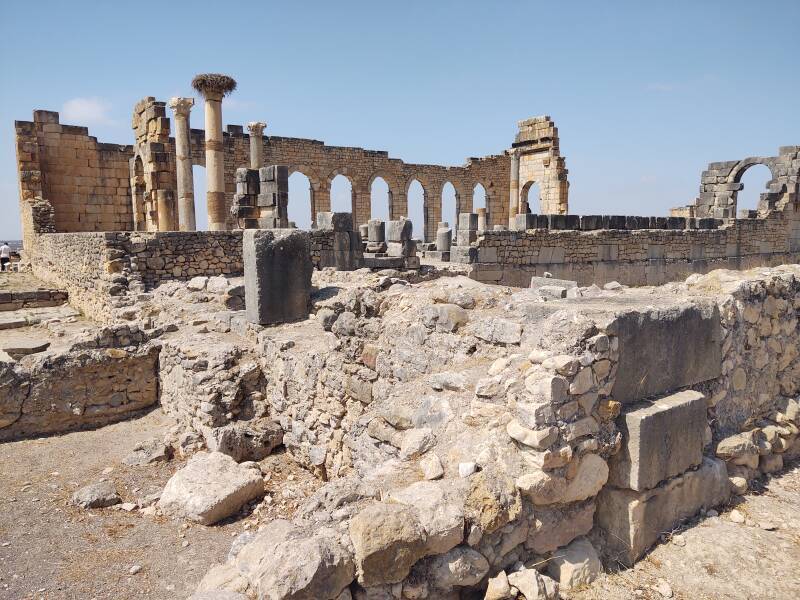
This is the aspe across one end of the basilica.

Starting around the fourth century, in the century after Volubilis fell, large Christian churches began to be built to a basilica plan. The entryway was called the narthex. The raised platform for the government officials became the place for the altar. The nave was kept clear for liturgical processions of the clergy, with the lay people standing in the aisles on either side.
Below is the view from one end of an aisle, diagonally across that aisle and the central nave toward the far end of the other aisle. This basilica is a little over 42 meters long by 22 meters wide, and it originally had two stories.

There probably was a very small Christian community at Volubilis before it fell, but the main religious facility was the Capitoline Temple.
It was dedicated to Jupiter, Juno, and Minerva, the three main deities of the Roman state.
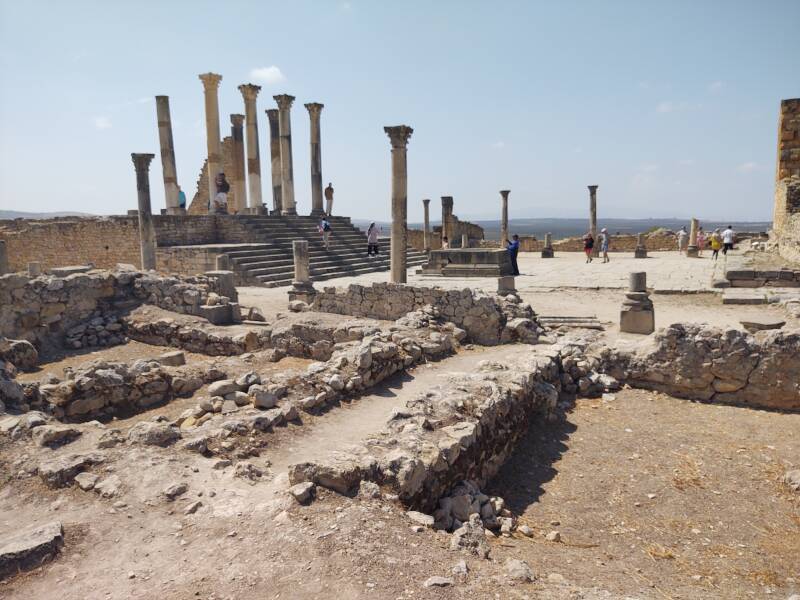
The people would have gathered in the courtyard in front of the temple, around a large open altar, to beseech the aid of the gods or to thank them for success in warfare or other civic undertakings.

Thirteen steps led up to the temple's portico and, beyond that, its single cella or naos or ναός, the inner chamber which would have held cult images of the deities. Votive offerings would have been made within the temple.

Sacrifices would have been made in the large altar in the courtyard.
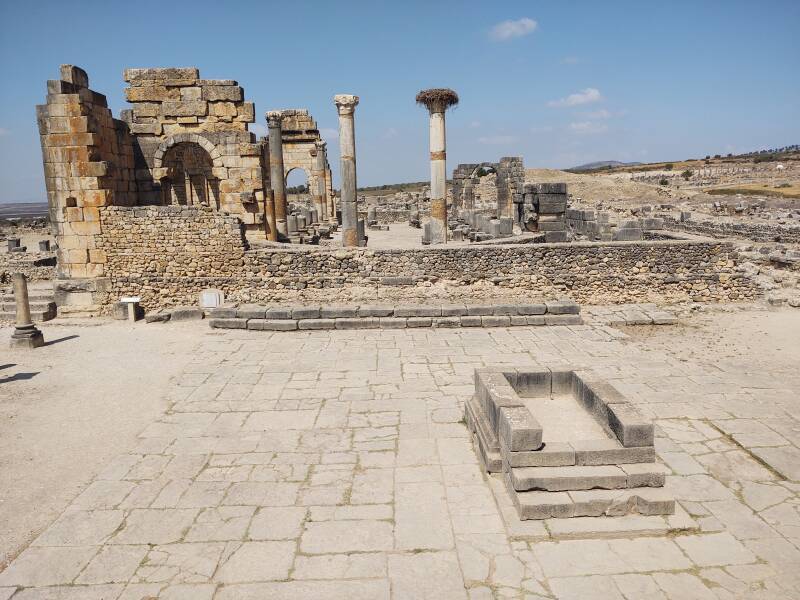
Morocco has a busy film industry, making movies for local production and also hosting foreign productions.
Martin Scorcese's 1988 The Last Temptation of Christ was entirely filmed in Morocco, with some scenes filmed at Volubilis. Here's Harry Dean Stanton playing Saul of Tarsus preaching to the people around that altar.
Arch of Caracalla
The triumphal Arch of Caracalla is at the end of the Decumanus Maximus, the city's main street.
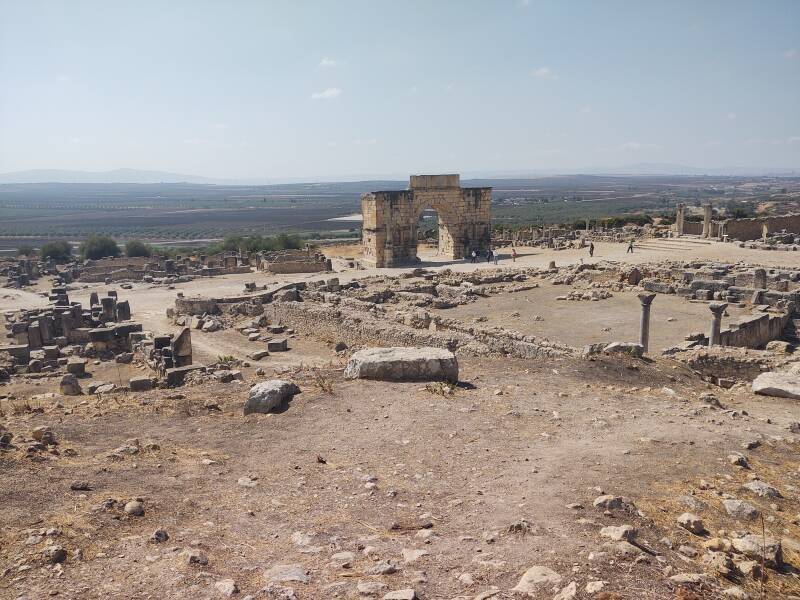
The city's governor had it built in 217 to honor the emperor Caracalla and his mother Julia Domna. Caracalla was of North African and Arab descent. His father Septimius Severus was from Leptis Magna, today's Khoms, Libya, and his mother was from Emesa, today's Homs, Syria.
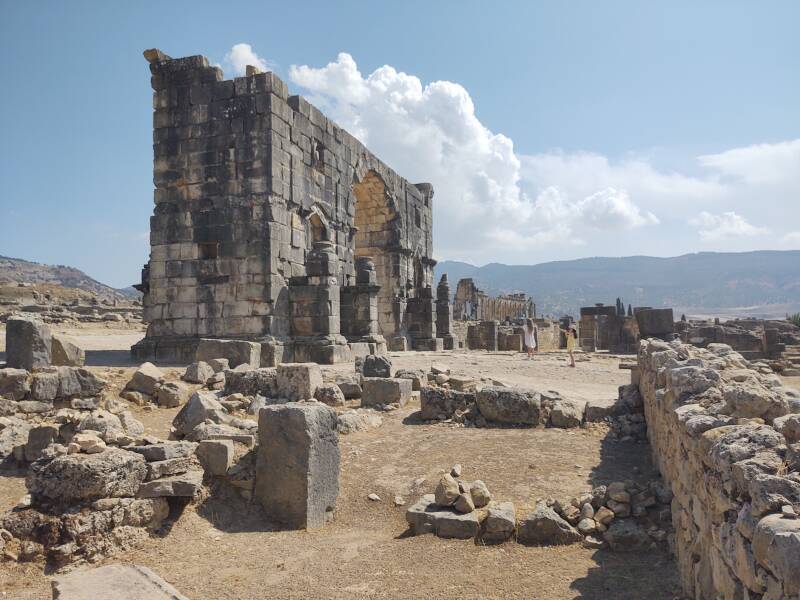
Caracalla had issued an edict in 212 declaring that all free men in the Roman Empire were to be given full Roman citizenship. That was a big benefit for the inhabitants of Volubilis. Unfortunately for them, both Caracalla and his mother had been assassinated by an usurper before the arch was finished.
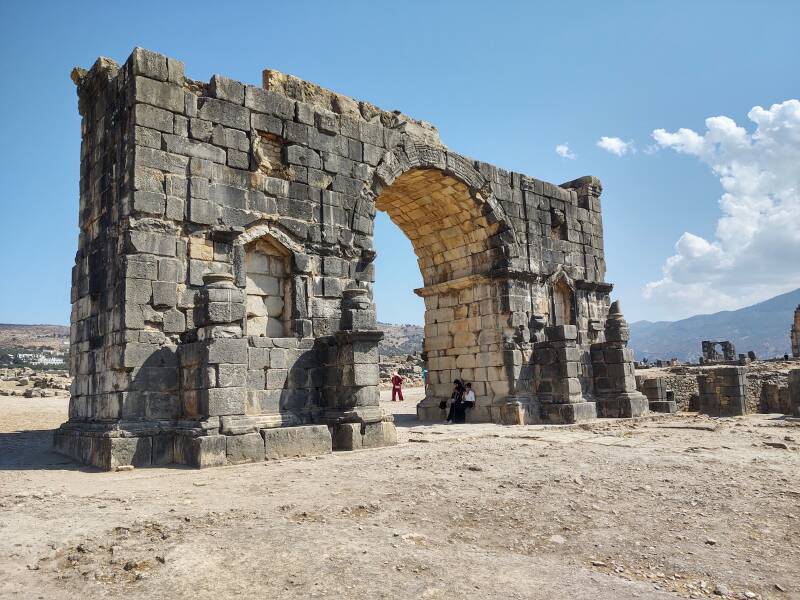
Northern District
Houses and public buildings in Volubilis had many pools, fountains, and other water features.
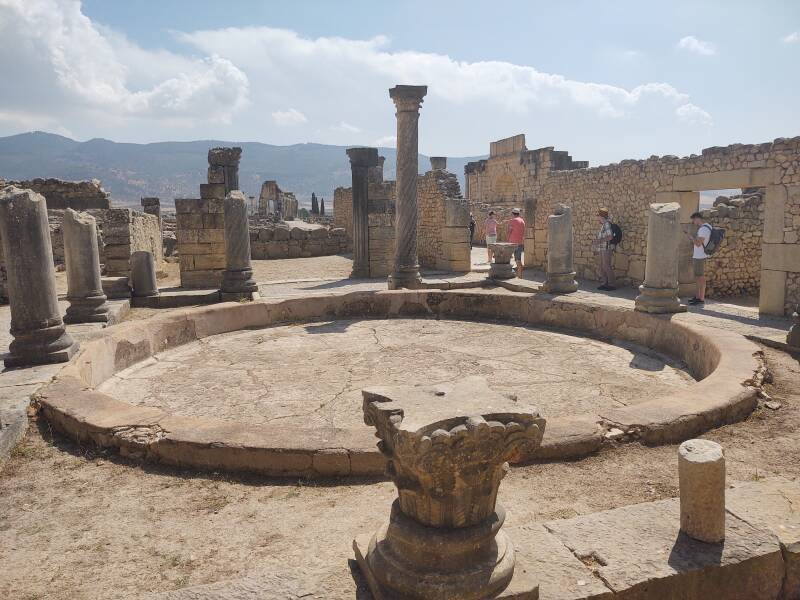
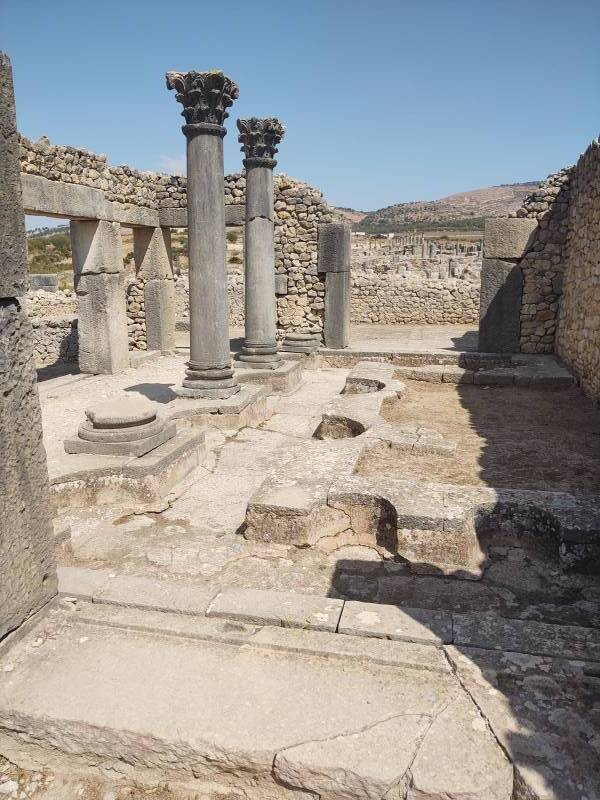
The House of the Knight, named for a bronze statue found here, has a mosaic of Bacchus coming across the sleeping Ariadne, who later bore him six children. The house was quite large with a section housing eight or nine shops plus a large olive-pressing complex.

Small prefabricated rail sections are still in the site, left over from archaeological work done during the French Protectorate.
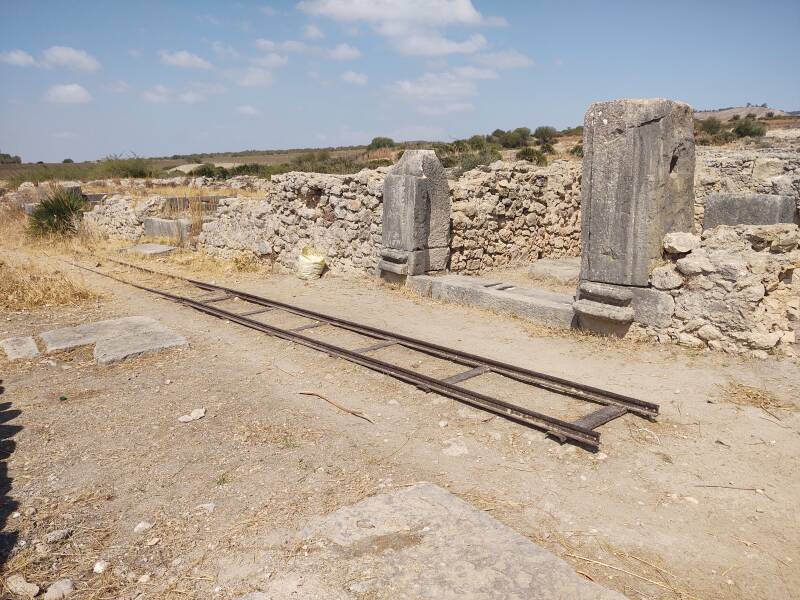

The House of the Labors of Hercules is named for its prominent mosaic. The house had 41 rooms with 2,000 square meters of space.
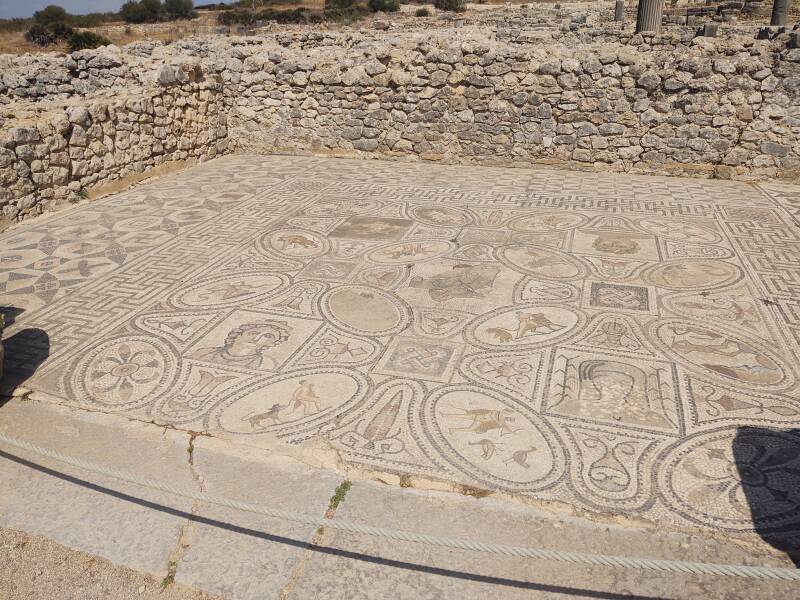
The Decumanus Maximus, the city's main street, continues up the slope to the Tingis Gate. That opened onto the road to the region's primary port of Tingis, today's Tangier.


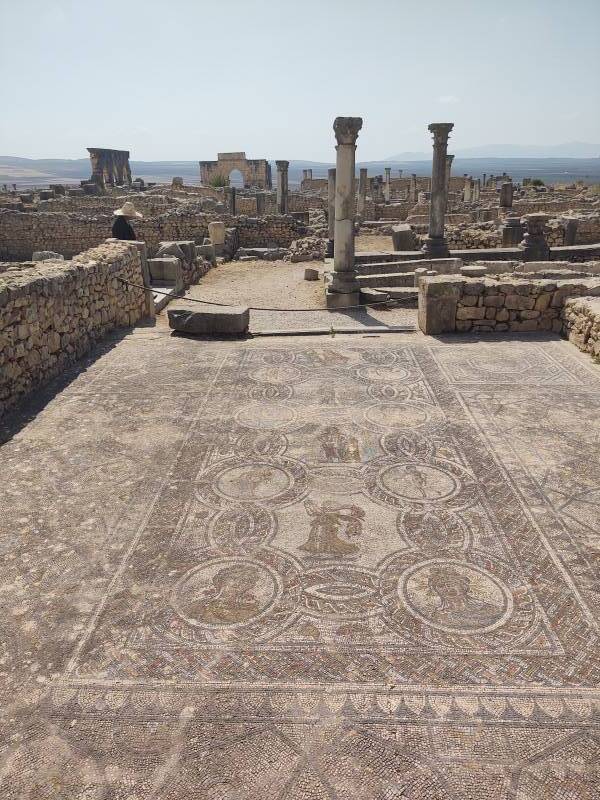
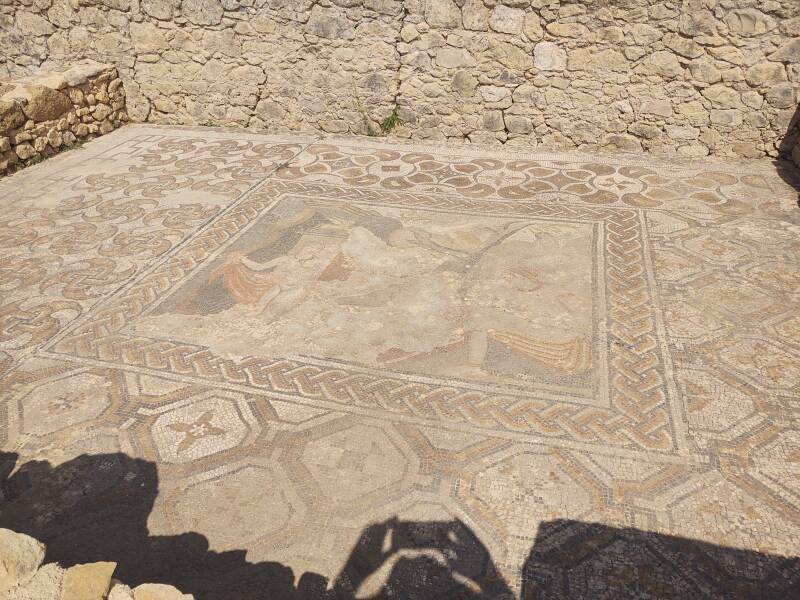
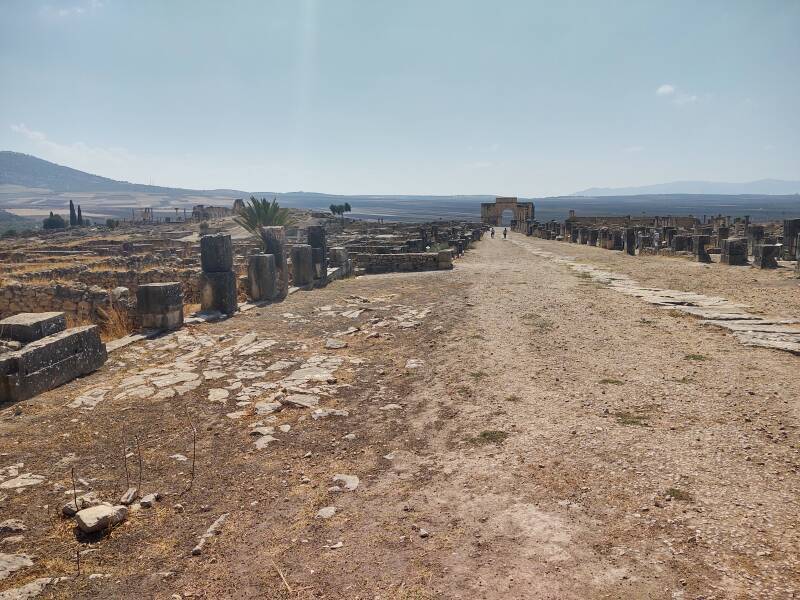
House of Venus
The House of Venus is southeast of the center. It was one of the most luxurious houses in the city with mosaics in eight rooms and seven corridors.

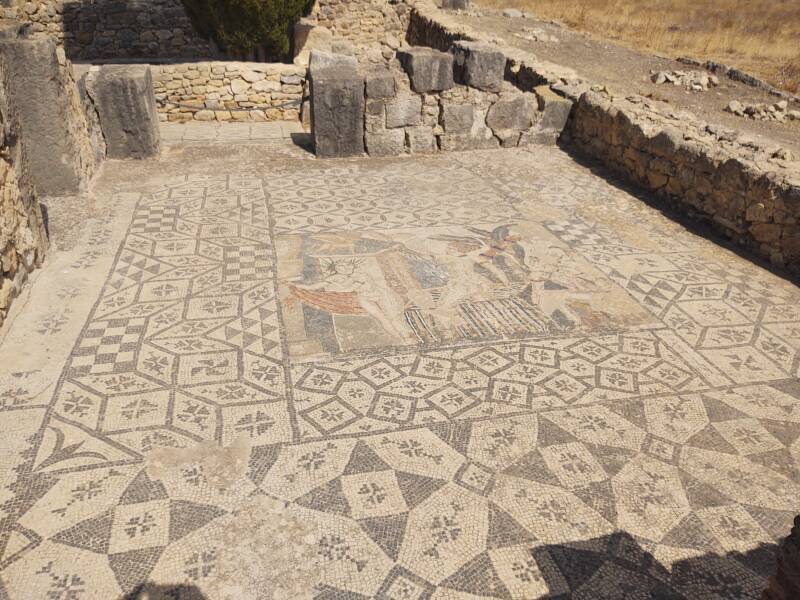
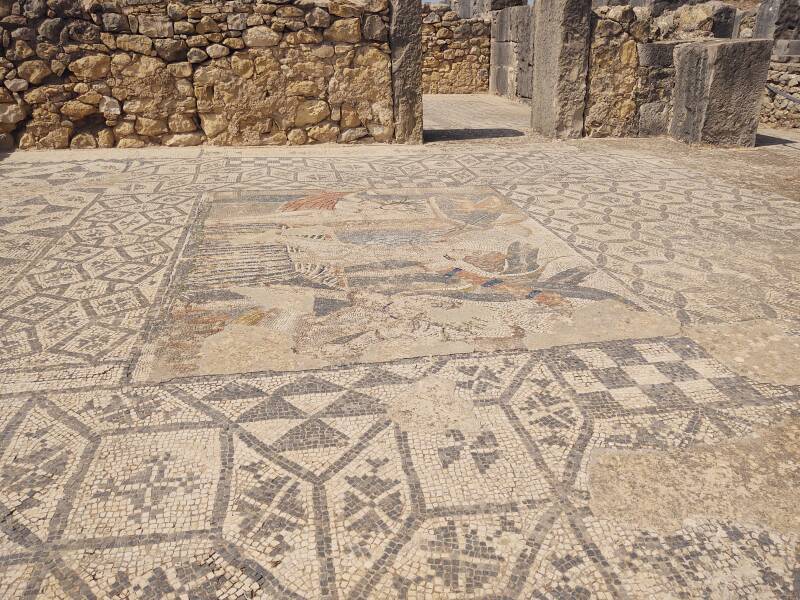
Return to Moulay Idris
Below is the view from the tumulus at the center of the site. Ahead of me is a low rise where a structure described speculatively as the "Temple of Saturn" once stood. It was built on top of, or perhaps converted from, a Punic era temple possibly dedicated to the Canaanite god Ba'al.
Beyond that is the town of Moulay Idris, four kilometers of hot and dry walking away. I needed to get started back.
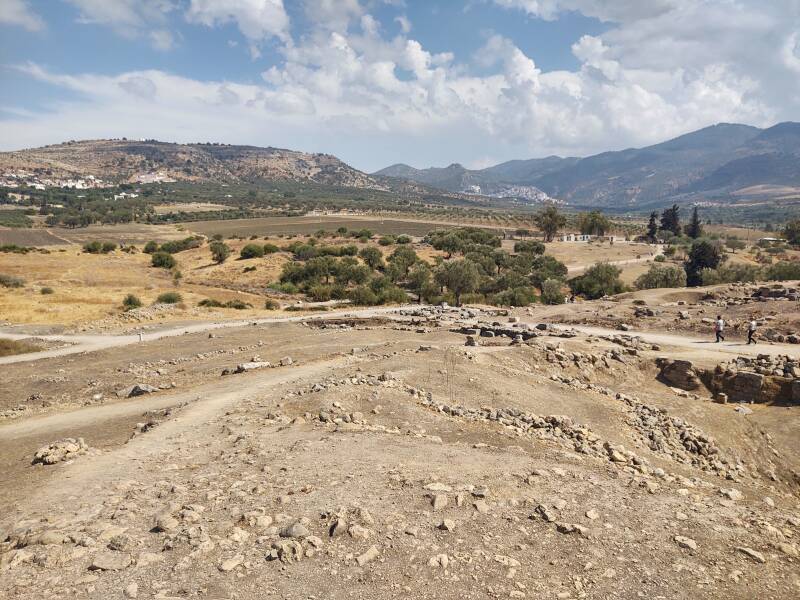
I was glad to get to a tea shop at the grand taxi lot. They brought a small glass of water along with my hot sweet mint tea, but I could have used much more.
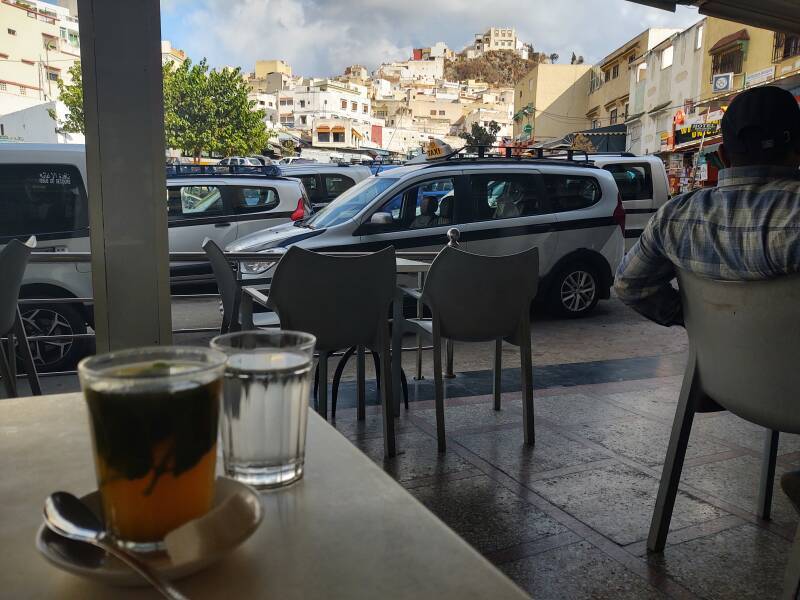
Asking for a water refill, I got an entire jar!
Now I could get rehydrated before arranging my return taxi collectif ride.

The next day in Meknès I would explore the kasbah of Moulay Isma'il.


Moulay, sometimes spelled Mulay or Lalla, is an Arabic title for the French Prince du sang or "Prince of the Blood", indicating legitimate descent in a male line of a royal house.